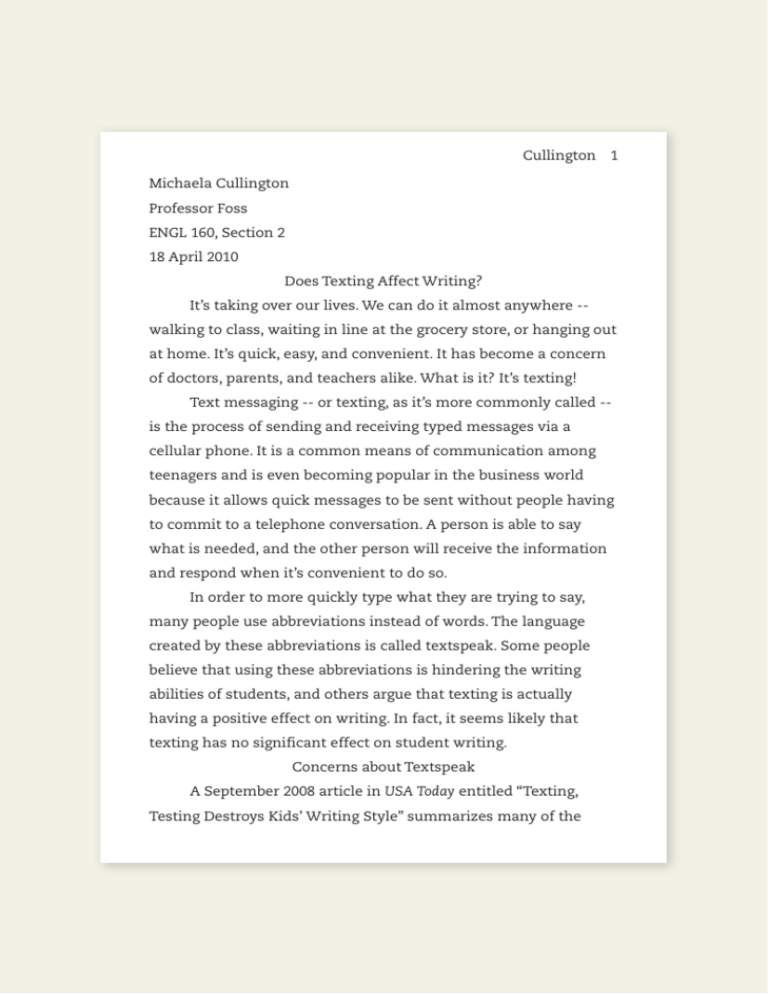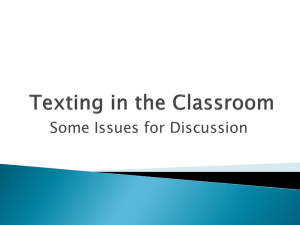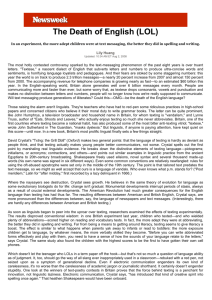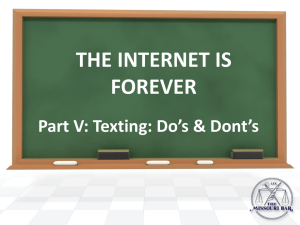Does Texting Affect Writing?
advertisement

Cullington 1 Michaela Cullington Professor Foss ENGL 160, Section 2 18 April 2010 Does Texting Affect Writing? It’s taking over our lives. We can do it almost anywhere -walking to class, waiting in line at the grocery store, or hanging out at home. It’s quick, easy, and convenient. It has become a concern of doctors, parents, and teachers alike. What is it? It’s texting! Text messaging -- or texting, as it’s more commonly called -is the process of sending and receiving typed messages via a cellular phone. It is a common means of communication among teenagers and is even becoming popular in the business world because it allows quick messages to be sent without people having to commit to a telephone conversation. A person is able to say what is needed, and the other person will receive the information and respond when it’s convenient to do so. In order to more quickly type what they are trying to say, many people use abbreviations instead of words. The language created by these abbreviations is called textspeak. Some people believe that using these abbreviations is hindering the writing abilities of students, and others argue that texting is actually having a positive effect on writing. In fact, it seems likely that texting has no significant effect on student writing. Concerns about Textspeak A September 2008 article in USA Today entitled “Texting, Testing Destroys Kids’ Writing Style” summarizes many of the Cullington 2 most common complaints about the effect of texting. It states that according to the National Center for Education Statistics, only 25% of high school seniors are “proficient” writers. The article quotes Jacquie Ream, a former teacher and author of K.I.S.S. -- Keep It Short and Simple, a guide for writing more effectively. Ream states, “[W]e have a whole generation being raised without communication skills.” She blames the use of acronyms and shorthand in text messages for students’ inability to spell and ultimately to write well. Ream also points out that students struggle to convey emotion in their writing because, as she states, in text messages “emotions are always sideways smiley faces.” This debate became prominent after some teachers began to believe they were seeing a decline in the writing abilities of their students. Many attributed this perceived decline to the increasing popularity of text messaging and its use of abbreviations. Naomi Baron, a linguistics professor at American University, blames texting for what she sees as the fact that “so much of American society has become sloppy and laissez faire about the mechanics of writing” (“Should We Worry or LOL?”). Teachers report finding “2” for “to,” “gr8” for “great,” “dat” for “that,” and “wut” for “what,” among other examples of textspeak, in their students’ writing. A Minnesota teacher of the seventh and ninth grades says that she has to spend extra time in class editing papers and must “explicitly” remind her students that it is not acceptable to use text slang and abbreviations in writing (Walsh). Another English teacher believes that text language has become “second nature” to her students (Carey); they are so used to it that they do not even catch themselves doing it. Cullington 3 Many also complain that because texting does not stress the importance of punctuation, students are neglecting it in their formal writing. Teachers say that their students are forgetting commas, apostrophes, and even capital letters to begin sentences. Another complaint is that text messages lack emotion. Many argue that texts lack feeling because of their tendency to be short, brief, and to the point. Because students are not able to communicate emotion effectively through texts, some teachers worry, they may lose the ability to do so in writing. To get a more personal perspective on the question of how teachers perceive texting to be influencing student writing, I interviewed two of my former high school teachers -- my junioryear English teacher and my senior-year theology teacher. Both teachers stress the importance of writing in their courses. They maintain that they notice text abbreviations in their students’ writing often. To correct this problem, they point it out when it occurs and take points off for its use. They also remind their students to use proper sentence structure and complete sentences. The English teacher says that she believes texting inhibits good writing -- it reinforces simplistic writing that may be acceptable for conversation but is “not so good for critical thinking or analysis.” She suggests that texting tends to generate topic sentences without emphasizing the following explanation. According to these teachers, then, texting is inhibiting good writing. However, their evidence is limited, based on just a few personal experiences rather than on a significant amount of research. Cullington 4 Responses to Concerns about Textspeak In response to these complaints that texting is having a negative impact on student writing, others insist that texting should be viewed as beneficial because it provides students with motivation to write, practice in specific writing skills, and an opportunity to gain confidence in their writing. For example, Sternberg, Kaplan, and Borck argue that texting is a good way to motivate students: teens enjoy texting, and if they frequently write through texts, they will be more motivated to write formally. Texting also helps to spark students’ creativity, these authors argue, because they are always coming up with new ways to express their ideas (417). In addition, because they are engaging in written communication rather than oral speech, texting teens learn how to convey their message to a reader in as few words as possible. In his book Txtng: The Gr8 Db8, David Crystal discusses a study that concludes that texting actually helps foster “the ability to summarize and express oneself concisely” in writing (168). Furthermore, Crystal explains that texting actually helps people to “sharpen their diplomatic skills . . . [because] it allows more time to formulate their thoughts and express them carefully” (168). One language arts teacher from Minnesota believes that texting helps students develop their own “individual voice” (qtd. in Walsh). Perfecting such a voice allows the writer to offer personal insights and express feelings that will interest and engage readers. Supporters of texting also argue that it not only teaches elements of writing but provides extra practice to those who Cullington 5 struggle with the conventions of writing. As Crystal points out, children who struggle with literacy will not choose to use a technology that requires them to do something that is difficult for them. However, if they do choose to text, the experience will help them “overcome their awkwardness and develop their social and communication skills” (Txtng 171). Shirley Holm, a junior high school teacher, describes texting as a “comfortable form of communication” (qtd. in Walsh). Teenagers are used to texting, enjoy doing so, and as a result are always writing. Through this experience of writing in ways they enjoy, they can learn to take pleasure in writing formally. If students are continually writing in some form, they will eventually develop better skills. Furthermore, those who favor texting explain that with practice comes the confidence and courage to try new things, which some observers believe they are seeing happen with writing as a result of texting. Teenagers have, for example, created an entirely new language — one that uses abbreviations and symbols instead of words, does not require punctuation, and uses short, incomplete phrases throughout the entire conversation. It’s a way of speaking that is a language in and of itself. Crystal, among others, sees this “language evolution” as a positive effect of texting; he seems, in fact, fascinated that teenagers are capable of creating such a phenomenon, which he describes as the “latest manifestation of the human ability” (Txtng 175). David Warlick, a teacher and author of books about technology in the classroom, would agree with Crystal. He believes students should be given Cullington 6 credit for “inventing a new language ideal for communicating in a high-tech world” (qtd. in Carey). Methods I decided to conduct my own research into this controversy. I wanted to get different, more personal, perspectives on the issue. First, I surveyed seven students on their opinions about the impact of texting on writing. Second, I questioned two high school teachers, as noted above. Finally, in an effort to compare what students are actually doing to people’s perceptions of what they are doing, I analyzed student writing samples for instances of textspeak.1 To let students speak for themselves, I created a list of questions for seven high school and college students, some of my closest and most reliable friends. Although the number of respondents was small, I could trust my knowledge of them to help me interpret their responses. In addition, these students are very different from one another, and I believed their differences would allow for a wide array of thoughts and opinions on the issue. I was thus confident in the reliability and diversity of their answers but was cautious not to make too many assumptions because of the small sample size. I asked the students how long they had been texting; how often they texted; what types of abbreviations they used most and how often they used them; and whether they noticed themselves using any type of textspeak in their formal writing. In analyzing their responses, I looked for commonalities to help me draw conclusions about the students’ texting habits and if/how they believed their writing was affected. Cullington 7 I created a list of questions for teachers similar to the one for the students and asked two of my high school teachers to provide their input. I asked if they had noticed their students using textspeak in their writing assignments and, if so, how they dealt with it. I also asked if they believed texting had a positive or negative effect on writing. Next, I asked if they were texters themselves. And, finally, I solicited their opinions on what they believed should be done to prevent teens from using text abbreviations and other textspeak in their writing. I was surprised at how different the students’ replies and opinions were from the teachers’. I decided to find out for myself whose impressions were more accurate by comparing some students’ actual writing with students’ and teachers’ perceptions of that writing. To do this I looked at twenty samples of student writing — end-of-semester research arguments written in two first-year college writing courses with different instructors. The topics varied from increased airport security after September 11 to the weapons of the Vietnam War to autism, and lengths ranged from eight to ten pages. To analyze the papers for the presence of textspeak, I looked closely for use of abbreviations and other common slang terms, especially those usages which the students had stated in their surveys were most common. These included “hbu” (“How about you?”); “gtg” (“Got to go”); and “cuz” (“because”). I also looked for the numbers 2 and 4 used instead of the words “to” and “for.” Discussion of Findings My research suggests that texting actually has a minimal effect on student writing. It showed that students do not believe Cullington 8 textspeak is appropriate in formal writing assignments. They recognize the difference between texting friends and writing formally and know what is appropriate in each situation. This was proven true in the student samples, in which no examples of textspeak were used. Many experts would agree that there is no harm in textspeak, as long as students continue to be taught and reminded that occasions where formal language is expected are not the place for it. As Crystal explains, the purpose of the abbreviations used in text messages is not to replace language but rather to make quick communications shorter and easier, since in a standard text message, the texter is allowed only 160 characters for a communication (“Texting” 81). Dennis Baron, an English and linguistics professor at the University of Illinois, has done much research on the effect of technology on writing, and his findings are aligned with those of my own study. In his book A Better Pencil: Readers, Writers, and the Digital Revolution, he concludes that students do not use textspeak in their writing. In fact, he suggests students do not even use abbreviations in their text messages very often. Baron says that college students have “put away such childish things, and many of them had already abandoned such signs of middle-school immaturity in high school” (qtd. in Golden). In surveying the high school and college students, I found that most have been texting for a few years, usually starting around ninth grade. The students said they generally text between thirty and a hundred messages every day but use abbreviations only occasionally, with the most common being “lol” (“Laugh out Cullington 9 loud”), “gtg” (“Got to go”), “hbu” (“How about you?”), “cuz” (“because”), and “jk” (“Just kidding”). None of them believed texting abbreviations were acceptable in formal writing. In fact, research has found that most students report that they do not use textspeak in formal writing. As one Minnesota high school student says, “[T] here is a time and a place for everything,” and formal writing is not the place for communicating the way she would if she were texting her friends (qtd. in Walsh). Another student admits that in writing for school she sometimes finds herself using these abbreviations. However, she notices and corrects them before handing in her final paper (Carey). One teacher reports that, despite texting, her students’ “formal writing remains solid.” She occasionally sees an abbreviation; however, it is in informal, “warm-up” writing. She believes that what students choose to use in everyday types of writing is up to them as long as they use standard English in formal writing (qtd. in Walsh). Also supporting my own research findings are those from a study which took place at a midwestern research university. This study involved eighty-six students who were taking an Introduction to Education course at the university. The participants were asked to complete a questionnaire that included questions about their texting habits, the spelling instruction they had received, and their proficiency at spelling. They also took a standardized spelling test. Before starting the study, the researchers had hypothesized that texting and the use of abbreviations would have a negative impact on the spelling abilities of the students. However, they found that the results did Cullington 10 not support their hypothesis. The researchers did note that text messaging is continuing to increase in popularity; therefore, this issue should continue to be examined (Shaw, Carlson, and Waxman). I myself am a frequent texter. I chat with my friends from home every day through texting. I also use texting to communicate with my school friends, perhaps to discuss what time we are going to meet for dinner or to ask quick questions about homework. According to my cell phone bill, I send and receive around 6,400 texts a month. In the messages I send, I rarely notice myself using abbreviations. The only time I use them is if I do not have time to write out the complete phrase. However, sometimes I find it more time-consuming to try to figure out how to abbreviate something so that my message will still be comprehensible. Since I rarely use abbreviations in my texting, I never use them in my formal writing. I know that they are unacceptable and that it would make me look unintelligent if I included acronyms and symbols instead of proper and formal language. I also have not noticed an effect on my spelling as a result of texting. I am confident in my spelling abilities, and even when I use an abbreviation, I know how to spell the word(s) it stands for. On the basis of my own research, expert research, and personal observations, I can confidently state that texting is not interfering with students’ use of standard written English and has no effect on their writing abilities in general. It is interesting to look at the dynamics of the arguments over these issues. Teachers and parents who claim that they are seeing a decline in the writing Cullington 11 abilities of their students and children mainly support the negative-impact argument. Other teachers and researchers suggest that texting provides a way for teens to practice writing in a casual setting and thus helps prepare them to write formally. Experts and students themselves, however, report that they see no effect, positive or negative. Anecdotal experiences should not overshadow the actual evidence. Cullington 12 Note 1. All participants in the study have given permission for their responses to be published. Cullington 13 Works Cited Baron, Dennis. A Better Pencil: Readers, Writers, and the Digital Revolution. Oxford: Oxford UP, 2009. Print. Carey, Bridget. “The Rise of Text, Instant Messaging Vernacular Slips into Schoolwork.” Miami Herald 6 Mar. 2007: n. pag. Academic Search Elite. Web. 27 Oct. 2009. Crystal, David. “Texting.” ELT Journal 62.1 (2008): 77–83. WilsonWeb. Web. 8 Nov. 2009. ---. Txtng: The Gr8 Db8. Oxford: Oxford UP, 2008. Print. Golden, Serena. Rev. of A Better Pencil. Inside Higher Ed, 18 Sept. 2009: n. pag. Web. 9 Nov. 2009. Shaw, Donita M., Carolyn Carlson, and Mickey Waxman. “An Exploratory Investigation into the Relationship between Text Messaging and Spelling.” New England Reading Association Journal 43 (2007): 57–62. WilsonWeb. Web. 8 Nov. 2009. “Should We Worry or LOL?” NEA Today Mar. 2004: 12. Academic Search Elite. Web. 27 Oct. 2009. Sternberg, Betty, Karen A. Kaplan, and Jennifer E. Borck. “Enhancing Adolescent Literacy Achievement through Integration of Technology in the Classroom.” Reading Research Quarterly 42 (2007): 416–20. WilsonWeb. Web. 8 Nov. 2009. “Texting, Testing Destroys Kids’ Writing Style.” USA Today 137.2760 (2008): 8. Academic Search Elite. Web. 9 Nov. 2009. Walsh, James. “Txt Msgs Creep in2 class; Some Say That’s gr8.” Star Tribune 23 Oct. 2007: n. pag. Academic Search Elite. Web. 27 Oct. 2009. “Texting and Writing.” Reprinted by permission of the author.





